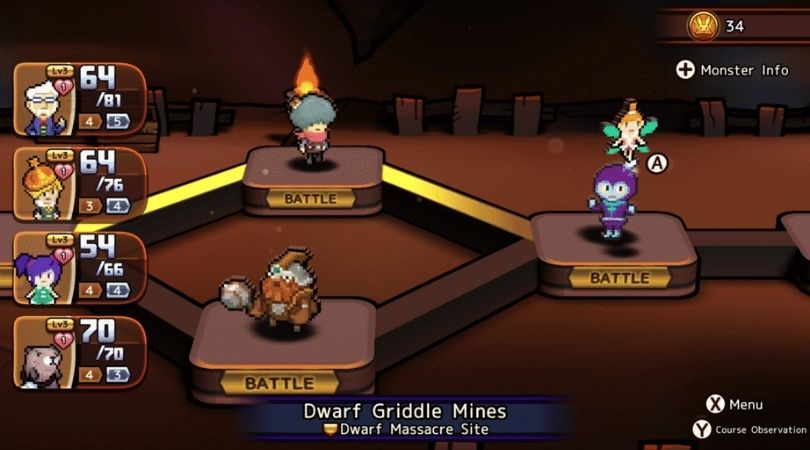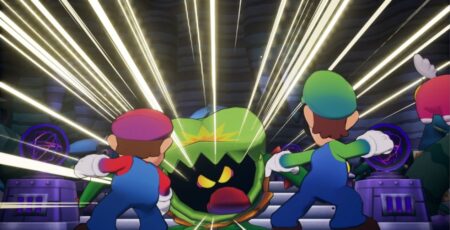Heroland was developed by FuRyu and Netchubiyori Ltd. and published by FuRyu, XSEED Games, and Marvelous Inc. You are an employee of Heroland, where visitors come to live out fantasies of finding treasure while clearing out dungeons filled with “monsters.” Your job is to guide these visitors through these battles. By giving pointers, sharing strategies, and tossing the occasional potion their way, you enable your customers to live the fantasy dream. This takes the form of participating in classic turn-based RPG game play. But, instead of controlling the whole party you only control your own character.
When booting up Heroland, the first thing that players will notice is its unique 3D pixel art style. Blending that nostalgic pixel art with a 3D look is something I’d never seen before. Watching the characters twist and bend as if made of rubber was a humorous sight that never got old. Both the character and monster designs lean into this charm wonderfully. Even the animations fit this charming feel splendidly. Characters bounce across the screen, almost as if some unseen child’s hand was walking them along. This charm is handled beautifully, right up until you get to the dialogue.
The dialogue presented to the player tries its hardest to be charming and fun. The cast of characters is filled with bizarre and unique individuals who feel ripe for some lighthearted mischief. What strives for fun quickly devolves into annoyance. Character shticks are often played on so heavy-handedly that they are old before the cut scene that introduced them is over. While all these text boxes can be fast-forwarded through, it hurts the experience of any RPG if you have to skip every story beat.
While the story may falter a bit in Heroland, the area where this title excels is in its gameplay. Within this lighthearted, charming exterior lies a challenging combat system that demands your attention, a bit of planning, and just a bit of luck.
Instead of controlling the entire on-screen group of heroes, as most RPGs would have you do, the player only controls their own character. The rest of the party will automatically perform attacks, cast spells, and heal each other when left to their own devices. When the player’s action is available, they gain access to several different ways to influence the battle’s outcome.
The most straightforward way the player aids the adventuring party is through dispensing items. Healing potions revives, and other items that restore special ability uses are all available to the player. Depending on your level though, you can only bring so many different items with you. So you need to plan accordingly.
The other way the player aids the party is by giving pointers. The player can give a broad strategy to the entire party to follow, such as everyone attacking this character or bringing up their guard. While these are useful for directing the broad flow of battle, sometimes, the player needs to get very particular with a single character. For that, the player can opt to give a single person a much more precise command. These commands can cover all the actions you would normally be able to use if you had direct control over the character in most RPGs. While I found this advisory role unique and fun, it does suffer from a couple of drawbacks.
Most RPGs take a little time for the gameplay to kick in. Early encounters are often mired in simply repeatedly pressing the attack command till things die. This struggle is heightened in the early stages of Heroland as the player isn’t even called upon to do that. The earliest encounters are so simple you basically watch them. The only action that is required is the occasional toss of a potion.

The other frustrating spot lies in the party A.I. When not being directed to attack a particular opponent, the party members tend to attack randomly. This leads to many battles feeling much more drawn out than they should be. While you can use your action to focus the party, it only lasts for each character’s next turn. After that, they will go back to attacking whatever they feel like.
The only other thing that might be frustrating to some is the need to grind levels. The main storyline’s difficulty will quickly get away from you, requiring the player to repeat side content just to keep up. At some points, my only options were story missions that were too tough and side missions that were far too easy. This left me grinding through repetitive side content that lacked the engagement the game requires when it’s at its best.
Outside of the dungeons themselves, there are several avenues the player can invest in to help improve their chances of survival. From genre staples like upgrading gear and restocking inventory to unique options like attending a staff meeting to learn about some of the upcoming dungeon’s quirks, players have many ways to customize their experience.
There are also some problems with the size of the fonts used in some of the menus and tutorial screens. Basically, it’s really small. I played this on my Nintendo Switch, and in handheld mode, some of the fonts were squint-inducing.
Lastly, there is an engaging friendship system at play in Heroland. By helping party members and giving them treasures found in the dungeons, you can increase their friendliness toward you. If the level gets high enough, you can unlock additional side quests. These provide more opportunities for gaining experience and earning loot, even if it also requires you to go through more dialogue.
When all is said and done, Heroland becomes a bit of a mixed bag. Charming graphics and a deep, uniquely enjoyable combat system are mired by obnoxious characters and a need to level grind. There is a lot to like about this game, just as long as you are willing to commit the time to find it.
Heroland is available now on the Nintendo Switch.
Heroland
-
Rating - 7.5/107.5/10
TL;DR
When all is said and done, Heroland ends up being a bit of a mixed bag. Charming graphics and a deep, uniquely enjoyable combat system are mired by obnoxious characters and a need to level grind.





